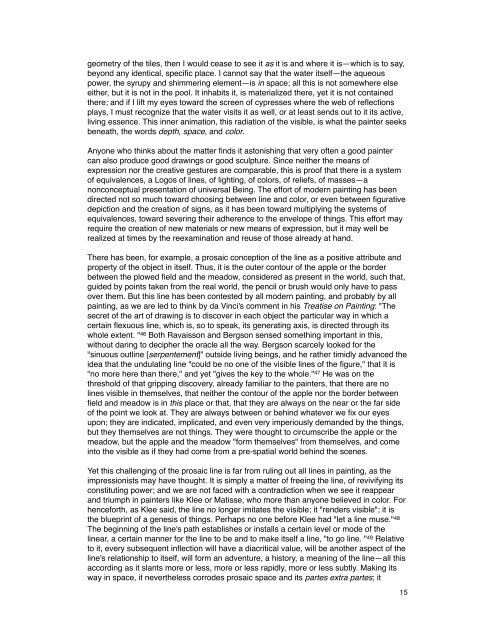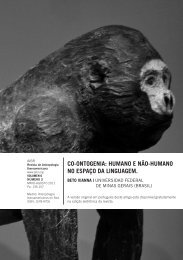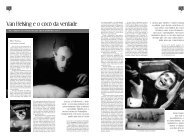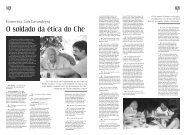Merleau-Ponty, 1964. Eye and mind. - Biolinguagem
Merleau-Ponty, 1964. Eye and mind. - Biolinguagem
Merleau-Ponty, 1964. Eye and mind. - Biolinguagem
- No tags were found...
You also want an ePaper? Increase the reach of your titles
YUMPU automatically turns print PDFs into web optimized ePapers that Google loves.
geometry of the tiles, then I would cease to see it as it is <strong>and</strong> where it is—which is to say,<br />
beyond any identical, specific place. I cannot say that the water itself—the aqueous<br />
power, the syrupy <strong>and</strong> shimmering element—is in space; all this is not somewhere else<br />
either, but it is not in the pool. It inhabits it, is materialized there, yet it is not contained<br />
there; <strong>and</strong> if I lift my eyes toward the screen of cypresses where the web of reflections<br />
plays, I must recognize that the water visits it as well, or at least sends out to it its active,<br />
living essence. This inner animation, this radiation of the visible, is what the painter seeks<br />
beneath, the words depth, space, <strong>and</strong> color.<br />
Anyone who thinks about the matter finds it astonishing that very often a good painter<br />
can also produce good drawings or good sculpture. Since neither the means of<br />
expression nor the creative gestures are comparable, this is proof that there is a system<br />
of equivalences, a Logos of lines, of lighting, of colors, of reliefs, of masses—a<br />
nonconceptual presentation of universal Being. The effort of modern painting has been<br />
directed not so much toward choosing between line <strong>and</strong> color, or even between figurative<br />
depiction <strong>and</strong> the creation of signs, as it has been toward multiplying the systems of<br />
equivalences, toward severing their adherence to the envelope of things. This effort may<br />
require the creation of new materials or new means of expression, but it may well be<br />
realized at times by the reexamination <strong>and</strong> reuse of those already at h<strong>and</strong>.<br />
There has been, for example, a prosaic conception of the line as a positive attribute <strong>and</strong><br />
property of the object in itself. Thus, it is the outer contour of the apple or the border<br />
between the plowed field <strong>and</strong> the meadow, considered as present in the world, such that,<br />
guided by points taken from the real world, the pencil or brush would only have to pass<br />
over them. But this line has been contested by all modern painting, <strong>and</strong> probably by all<br />
painting, as we are led to think by da Vinci's comment in his Treatise on Painting: "The<br />
secret of the art of drawing is to discover in each object the particular way in which a<br />
certain flexuous line, which is, so to speak, its generating axis, is directed through its<br />
whole extent. " 46 Both Ravaisson <strong>and</strong> Bergson sensed something important in this,<br />
without daring to decipher the oracle all the way. Bergson scarcely looked for the<br />
"sinuous outline [serpentement]" outside living beings, <strong>and</strong> he rather timidly advanced the<br />
idea that the undulating line "could be no one of the visible lines of the figure," that it is<br />
"no more here than there," <strong>and</strong> yet "gives the key to the whole." 47 He was on the<br />
threshold of that gripping discovery, already familiar to the painters, that there are no<br />
lines visible in themselves, that neither the contour of the apple nor the border between<br />
field <strong>and</strong> meadow is in this place or that, that they are always on the near or the far side<br />
of the point we look at. They are always between or behind whatever we fix our eyes<br />
upon; they are indicated, implicated, <strong>and</strong> even very imperiously dem<strong>and</strong>ed by the things,<br />
but they themselves are not things. They were thought to circumscribe the apple or the<br />
meadow, but the apple <strong>and</strong> the meadow "form themselves" from themselves, <strong>and</strong> come<br />
into the visible as if they had come from a pre-spatial world behind the scenes.<br />
Yet this challenging of the prosaic line is far from ruling out all lines in painting, as the<br />
impressionists may have thought. It is simply a matter of freeing the line, of revivifying its<br />
constituting power; <strong>and</strong> we are not faced with a contradiction when we see it reappear<br />
<strong>and</strong> triumph in painters like Klee or Matisse, who more than anyone believed in color. For<br />
henceforth, as Klee said, the line no longer imitates the visible; it "renders visible"; it is<br />
the blueprint of a genesis of things. Perhaps no one before Klee had "let a line muse." 48<br />
The beginning of the line's path establishes or installs a certain level or mode of the<br />
linear, a certain manner for the line to be <strong>and</strong> to make itself a line, "to go line. " 49 Relative<br />
to it, every subsequent inflection will have a diacritical value, will be another aspect of the<br />
line's relationship to itself, will form an adventure, a history, a meaning of the line—all this<br />
according as it slants more or less, more or less rapidly, more or less subtly. Making its<br />
way in space, it nevertheless corrodes prosaic space <strong>and</strong> its partes extra partes; it<br />
15









